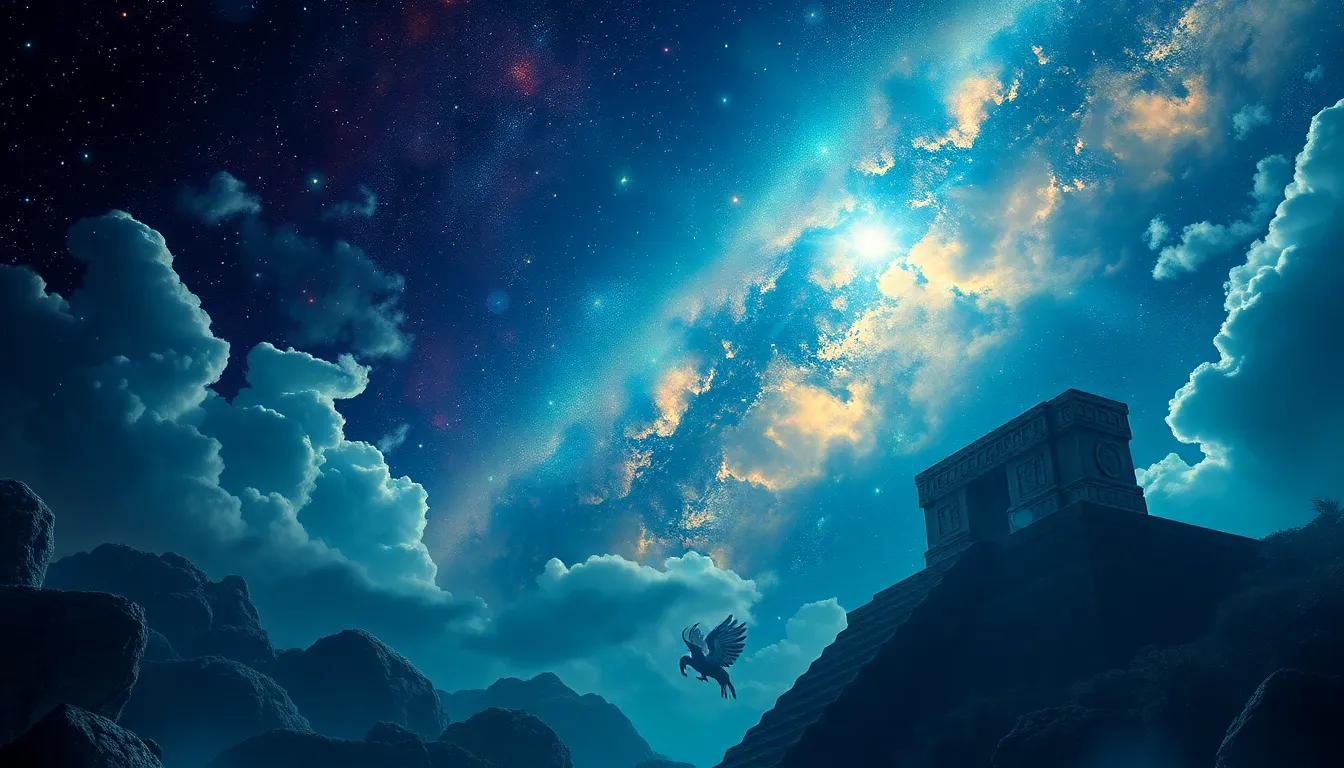The Mayan Sky: A Celestial Tapestry of Gods and Goddesses
I. Introduction
The sky held immense significance in Mayan culture, serving as a canvas for the gods and a guide for the people. It was not merely a backdrop to daily life but a dynamic realm that influenced agriculture, rituals, and social order. The Mayans viewed the cosmos as a complex tapestry woven with the lives of their deities, each governing different aspects of existence.
Among the pantheon of Mayan gods and goddesses, many were directly associated with celestial bodies and phenomena. This article aims to explore the intricate connections between these deities and the sky, highlighting how celestial events shaped Mayan mythology and daily practices.
II. The Mayan Cosmology: Understanding the Universe
The Mayan worldview was deeply rooted in their cosmological beliefs, which posited a universe divided into multiple realms: the heavens, the earth, and the underworld. The heavens were inhabited by gods, while the earth was home to humans, and the underworld, known as Xibalba, was a place of trials and darkness.
The sky played a pivotal role in Mayan mythology and daily life. It was seen as a source of both life and death, with celestial cycles dictating agricultural practices. Key celestial symbols included:
- The Sun: A symbol of life and vitality, representing the god Kinich Ahau.
- The Moon: Associated with Ix Chel, the goddess of fertility and medicine.
- The Stars: Seen as ancestors or divine beings guiding the living.
III. Major Mayan Deities Associated with the Sky
Several significant gods and goddesses were intimately connected to the sky and its phenomena:
1. Itzamná: The Creator God and God of the Heavens
Itzamná was one of the most important deities in the Mayan pantheon, often depicted as a wise old man. He was the creator god who governed the heavens and was associated with wisdom, night, and the moon. Itzamná was believed to be the provider of knowledge and a guide for the Mayans in their understanding of the universe.
2. Kukulkan: The Feathered Serpent and Agricultural Deity
Kukulkan, also known as Quetzalcoatl in other Mesoamerican cultures, was a key figure associated with the sky, rain, and agriculture. This feathered serpent represented the merging of the earthly and celestial realms, embodying the vital connection between the sky and agricultural fertility.
3. Ix Chel: The Goddess of the Moon and Fertility
Ix Chel was revered as the goddess of the moon, love, and fertility. She was often portrayed as a powerful woman who controlled the tides and the cycles of life. Her influence extended to healing and childbirth, making her an essential figure in Mayan rituals related to health and reproduction.
IV. Celestial Events and Their Significance
Celestial events such as eclipses, solstices, and equinoxes were of great importance to the Mayans. They were seen as manifestations of the will of the gods and were meticulously observed and interpreted.
- Eclipses: Often viewed as omens, eclipses could signify the anger of the gods or impending change.
- Solstices: Marking the longest and shortest days of the year, these events were crucial for agricultural planning.
- Equinoxes: Signifying balance, equinoxes were times of reflection and renewal.
The Mayans celebrated these celestial phenomena with various rituals and ceremonies, reinforcing their connection to the divine and the cycles of nature.
V. The Mayan Calendar: A Celestial Framework
The Mayan calendar systems, primarily the Tzolk’in and Haab’, were intricately tied to their observations of celestial movements. The Tzolk’in, a 260-day calendar, was used for ceremonial purposes, while the Haab’, a 365-day solar calendar, governed agricultural and civil life.
This connection between the calendar and celestial observations was vital for:
- Determining planting and harvesting times.
- Scheduling religious ceremonies and festivals.
- Tracking the movements of celestial bodies as signs from the gods.
Timekeeping was not just practical; it was a spiritual practice that intertwined the lives of the Mayans with their gods and the cosmos.
VI. Astronomy and Architecture: Alignments with the Cosmos
Astronomy played a crucial role in Mayan architecture. Many structures, including pyramids and observatories, were built with precise alignments to celestial bodies.
Iconic structures such as:
- El Caracol: An observatory in Chichen Itza, used for tracking celestial events.
- Pyramids of Tikal: Aligned with the movements of the sun and stars.
- Temple of the Inscriptions: Reflects the importance of celestial cycles in funerary practices.
This architectural alignment demonstrates the Mayans’ profound understanding of the heavens and their desire to bridge the earthly and divine realms.
VII. The Legacy of Mayan Sky Beliefs
The celestial beliefs of the Mayans continue to influence contemporary culture and spirituality. Many modern Maya communities preserve their astronomical knowledge and integrate it into their cultural practices.
Additionally, the impact of tourism and academic scholarship has fostered a renewed interest in Mayan mythology and astronomy, leading to greater appreciation and understanding of their celestial tapestry.
VIII. Conclusion
The relationship between the Mayan sky and their deities is a rich tapestry woven through mythology, ritual, and daily life. The significance of celestial phenomena in shaping their beliefs and practices serves as a reminder of the interconnectedness of life and the cosmos.
Understanding the Mayan celestial world allows us to appreciate not only their historical context but also their enduring legacy in contemporary culture. The Mayan sky, filled with gods and celestial events, remains a source of inspiration and fascination for people around the world.



